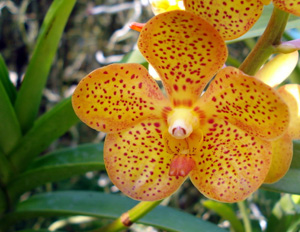Culture
Myanmar Flora & Fauna
- Details
- Hits: 15099
 Myanmar Flora & Fauna
Myanmar Flora & Fauna
Photo Credit - www.pinterest.com
Flora
As in the rest of tropical Asia. most indigenous vegetation in Myanmar is associated with two basic types of tropical forest: monsoon forest (with a distinctive dry season of three months or more) and rainforest (where rain falls more than nine months per year).
Monsoon forests are marked by deciduous tree varieties which shed their leaves during the dry season to conserve water; rainforests are typically evergreen. The area stretching from Yangon to Myitkyina mainly contains monsoon forests while peninsular Myanmar south of Mawlamyine is predominantly a rainforest zone. There is much overlap of the two - some forest zones support a mix of monsoon forest and rainforest vegetation.
In the mountainous Himalayan region above the Tropic of Cancer. Myanmar's flora is characterised by subtropical broadleaf evergreen forest up to 2000 metres; temperate semi-deciduous broadleaf rainforest from 2000 to 3000 metres; and evergreen coniferous and subalpine snow forest passing into alpine scrub above 3000 metres.
Along the Rakhine and Taninthayi coasts. tidal forests occur in river estuaries. lagoons. tidal creeks and along low islands. Such woodlands are characterised by mangrove and other coastal trees which grow in mud and are resistant to sea water. Beach and dune forests. which grow along these same coasts above the high tide line. consist of palms. hibiscus. casuarinas and other tree varieties which can withstand high winds and occasional storm-sent waves.
The country's most famous flora includes an incredible array of fruit trees. over 25.000 flowering species. a variety of tropical hardwoods and bamboo. Of the latter. considered one of Asia's more renewable plant resources. Myanmar may possibly contain more species than any country outside China. One pure stand of bamboo in Rakhine State extends over 7770 sq km. Cane and rattan are also plentiful.
Myanmar holds 75% of the world's reserves of Tectona grandis; better known as teak to English speakers. kyun to the Burmese. This dense. long-wearing. highly prized hardwood is one of Myanmar's most important exports. for which the biggest consumers are Hong Kong. Singapore. Thailand and India.

Photo Credit - www.pinterest.com
Fauna
The most comprehensive wildlife survey available today was undertaken by the Bombay Natural History Society between 1912 and 1921 and published as the Mammal Survey of India. Myanmar and Ceylon. In Myanmar The Wild Animals of Myanmar. published in 1967. is the most recent work available and even this volume simply contains extracts from various surveys carried out by the British between 1912 and 1941. with a few observations dating to 1961.
As with flora. Myanmar's wildlife variation is closely affiliated with geographic and climatic differences. Hence the indigenous fauna of the country's northern half is mostly of Indo-Chinese origin while that of the south is generally Syndic (ie typical of Malaysia. Sumatra. Borneo and Java). In the Himalayan region north of the Tropic of Cancer. fauna shares the Indian realm with areas of north-eastern India. The large overlap area between zoogeographical and vegetative zones - extending from around Myitkyina in the north to the Bago Yoma in the central region - means that much of Myanmar is a potential habitat for plants and animals from all three zones.
Myanmar is rich in bird life. with an estimated one thousand resident and migrating species. Coastal and inland waterways of the delta and the southern peninsula are especially important habitats for South-East Asian waterfowl.
Distinctive mammals of renown - found in dwindling numbers within the more heavily forested areas of Myanmar- include leopards. jungle cats. fishing cats. civets. Indian mongoose. crab-eating mongoose. Himalayan bear. Asiatic black bears. Malayan sun bears. gaur (Indian bison). banteng (wild cattle). serow (an Asiatic mountain goat). wild boar. sambar. barking deer. mouse deer. tapirs. pangolin. gibbons. macaques. dolphins and dugongs.
An estimated 2000 tigers are thought to inhabit the primary forests. about four times as many as in neighbouring Thailand. Around 10.000 Asiatic elephants - roughly a third of all those trotting the planet - are widely distributed in Myanmar. Among these are 6000 pachyderms that make up the world's largest herd of working elephants. most of which are used in logging and agriculture. It's encouraging that this number exceeds by a thousand that tallied by English scholar F T Morehead in his 1944 treatise The Forests of Myanmar.
Both the one-horned rhinoceros and the Asiatic two-horned rhinoceros are believed to survive in very small numbers near the Thai border in the Kayin State. The rare red panda (or cat bear) was last sighted in northern Myanmar in the early 1960s but is still thought to live in Kachin State forests above 2000 metres.
Herpetofauna include four sea-turtle species along with numerous snake varieties. of which an astounding 52 are venomous. These include the common cobra. king cobra. banded krait. Malayan viper. green viper and Russell's pit viper.





